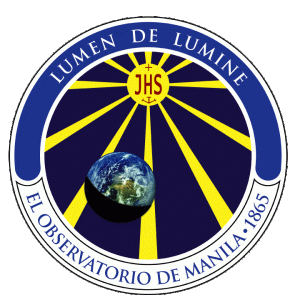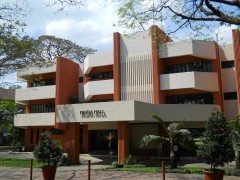Manila Observatory’s seal: a scientific and religious interpretation
February 17, 2011 Leave a comment
by Quirino Sugon Jr.
In heraldic terms, the Manila Observatory’s seal is an unsupported circular shield. The rays form a gyronny of twenty-four (24), gold on black field, meeting at slightly above the shield’s center, so that the vertical and horizontal rays form the Latin cross. The first charge is a circle labeled IHS, with a cross above and an anchor below. This circle is placed at the intersection of the rays. The second charge is the earth illumined by the sun, dividing the earth into dayside and night side. The earth is at the lower field, dexter side. At the upper rim of the shield is emblazoned the motto “Lumen de Lumine”, white on on blue. On the lower rim of the shield is emblazoned “El Observatorio de Manila. 1865”, blue on white.
I. SCIENTIFIC INTERPRETATION
The basic design is that of the Copernican Heliocentric System. The sun is at the center with twelve rays shining outward. The planet’s orbit is described by the rim of the shield: this is the deferent circle whose center is displaced downwards from the sun by a pronounced equant. The lines draw from the sun to the planet do not sweep out equal areas in equal times, so they do not follow Kepler 2nd Law. Rather, the rays sweep out equal angles in equal times which are the hands of a clock. The rays from the sun form 24 divisions alternating in gold and black. This corresponds to the division of the day into 24 hours. The rays may also correspond to the angles of a compass with the horizontal and vertical rays forming the West-East and North-South directions. The + sign and the anchor suggests the origin of a Cartesian coordinate system. They may also refer to the sun as the fixed point in the solar system.
The earth is lit by the sun, separating the nightside and dayside. The nightside of the earth forms a crescent which represents the moon. The earth is displaced from the vertical, making it visually unstable like a pendulum, suggesting movement. The pendulum’s pivot point is the sun marked by the + sign and the anchor. The swinging of the pendulum marks the measure of time. Also, the lines connecting the earth and the pivot point in the sun suggests the words of Archimedes concerning the lever: “Give me a place to stand and I shall move the world.”
The motto “Lumen de Lumine” suggests optics: refracted and reflected light are obtained from the incident light. This is the subject of telescope design, solar spectroscopy, and satellite imaging. Indeed, the point of view of the seal is from a spaceship or satellite, taking the picture of both the earth and sun.
II. RELIGIOUS INTERPRETATION
A. Jesuit Standard and Roman Catacombs
The symbol of the Jesuits is bright (straight rays), fiery (wavy rays) sun (circle) marked with IHS with a Latin cross above the letters and three nails below. The symbol is black on a white field.
In the Manila Observatory seal, the IHS remained but the cross was simplified to a Greek cross similar to an addition operation symbol. The three nails were connected to form the base of an anchor. It thus appears that the cross and the anchor form a single object in the background of IHS. The straight and wavy rays are replaced by 24 lines emanating from the sun’s center. The sun and the 12 regions formed by the rays are colored gold on black field. The gold connotes both bright and hot. The black connotes the darkness of of the night sky (c.f. Gen 1:2).
The IHS is a three-letter acronym based on the first three letters of Christ in “Jesus” in Greek (, Latinized IHSOVS). The IHS is also the acronym of “In hos signos“, which is a shortened form of Latinized phrase in Greek which means “In this sign you will conquer”—the words heard by Constantine when he saw in a vision the cross of Christ before the decisive Battle of the Milvian Bridge, which led to the adoption of Christianity as the official religion of the Roman Empire. Just as Constantine painted the standards of his legions with the first two letters
and
of Christ in Greek,
, so too did the Jesuits painted Christ’s name in their standard, as they fight the armies who follow the standard of Satan.
The Anchor is an ancient symbol of hope for those who died in Christ, as depicted in the Roman catacombs in the first centuries of Christianity. This symbol is based on the Letter of Paul to the Hebrews:
So when God wanted to give the heirs of his promise an even clearer demonstration of the immutability of his purpose, he intervened with an oath, so that by two immutable things, in which it was impossible for God to lie, we who have taken refuge might be strongly encouraged to hold fast to the hope that lies before us. This we have as an anchor of the soul, sure and firm, which reaches into the interior behind the veil, where Jesus has entered on our behalf as forerunner, becoming high priest forever according to the order of Melchizedek. (Heb 6:17-20)
In the catacombs of St. Sebastian, the anchor is drawn beside the Chi-Rho and the fish. The fish in Greek is Ichthys, which can be read as an acrostic of Ancient Greek words that translate to “Jesus Christ God’s son Savior”. Since IHS also stands for Christ, then the juxtaposition of the IHS and the anchor represent the catacombs and the persecution of Christianity. As Christ said, “If they persecuted me, they will also persecute you. If they kept my word, they will also keep yours” (Jn 15:20).
In heraldry, the rule of the tincture states that metal must never be placed upon metal, such as the juxtaposition of two colors white (silver) and yellow (gold). When this happens, the unusual nature of the bearer stands out, such as in the flags of two holy places: Vatican and the Kingdom of Jerusalem. In the seal of the Manila Observatory, gold is on black, so the rules of heraldry are not broken; however, the golden rays reach the silver white on the shield’s rim. This is unusual, and so are the Jesuits: only the Jesuits dare to call their society not after the name of their founder Ignatius, like the Franciscans and the Dominicans did, but after Christ Himself: “Society of Jesus”.
B. Lumen de Lumine and Prologue of John
The Manila Observatory’s motto Lumen de Lumine or Light of Light, is taken from the Nicene-Constantinopolitan Creed, the longer form of the Apostle’s Creed. The motto refers to Christ:
And in one Lord Jesus Christ, the only-begotten Son of God, begotten of the Father before all worlds (aeons), Light of Light, very God of very God, begotten, not made, being of one substance with the Father.
Light of Light uses a physical properties of light to describe the relationship of the Father and the Son. As St. Augustine said, “The Son alone is the Image of the Father.”
In the seal, the sun is marked by IHS and the cross, and rays of the sun light up the earth. Since IHS is Christ, then Christ, the sun of Justice in Malachi (3:20), is the true Light of the World. As the Prologue of John states:
In the beginning was the Word, and the Word was with God, and the Word was God. He was in the beginning with God. All things came to be through him, and without him nothing came to be. What came to be through him was life, and this life was the light of the human race; the light shines in the darkness, and the darkness has not overcome it. (Jn 1:1–5)
Just as the orbit of the earth around the sun results to the seasons of the year–Winter, Spring, Summer, and Fall–so, too, does the orbit of the world around Christ and His Cross result to the liturgical seasons: Advent, Christmas, Lent, and Ordinary Time. Indeed, the system of leap years in the Gregorian Calendar was introduced by Lilius and perfected by the Jesuit Christopher Clavius (1538-1612) in order to prevent the slow backward drift of Easter from the Vernal Equinox of March 21 as stipulated by the Council of Nicaea (AD 325).
The Gospel of John was originally written in Greek. In Greek, the “Word” is “Logos”. The Logos was adopted by Heraclitus (ca. 535–475 BC) to denote the principle of order and knowledge. This is why most of the traditional sciences ends in “–logy” which comes from “logos”. And the Manila Observatory has many of these sciences under its divisions: seismology, hydrology, meteorology, and climatology. Of course, not all sciences ends with “–logy” but the end of physical sciences remains: to know the principle of order behind the physical universe. And this knowledge starts with making distinctions, by discriminating light from darkness, day from night, sea from sky, land from sea, plants from animals, animals from man, and man from woman. The study of the sciences should therefore lead to the understanding of Creation, right to the beginning of time when God said, “‘Let there be light,’ and there was light.” (Gen 1:3). And the study of the sciences should lead to the one source of all sciences: the Logos, the Christ, for “all things came to be through him, and without him nothing came to be” (Jn 1:3). This is the Jesuit vision of the world.
C. Mary and Ateneo de Manila University
The colors blue and white on the shield’s rim are the colors of Ateneo de Manila University. These colors symbolizes Mary, the Patroness of Ateneo de Manila University under the title of the Immaculate Conception. As the Ateneo’s Alma Mater Song, “Song for Mary,” states:
Mary for you! For your white and blue! We pray you’ll keep us, Mary, constantly true! We pray you’ll keep us, Mary, faithful to you!
With blue and white surrounding the seal fo the Manila Observatory, this means two things: the Observatory is inside the walls of Ateneo de Manila University and the Observatory is under the patronage of the Immaculate Conception. This is true since the founding of the Observatory inside the Ateneo de Municipal de Manila in Manila in 1865. This remains true since the refounding of the Observatory in 1963 inside the present Ateneo de Manila University in Loyola Heights, Quezon City.
In Marian iconography, Mary is usually drawn with a crown of twelve stars as described in the Book of Revelation:
A great sign appeared in the sky, a woman clothed with the sun, with the moon under her feet, and on her head a crown of twelve stars. (Rv 12:1)
These twelve stars are drawn as twelve rays in the seal, because the stars are shining. The flag of the European union–with twelve gold stars arranged in circle on a blue field–for example, was inspired by Marian iconography, as attested by its original designers Arsène Heitz and Paul Michel Gabriel Lévy, both Catholics.
The crescent moon, which symbolizes Mary’s perpetual virginity, is represented by the crescent darkside of the earth. The crescent moon can be seen in the icon of the Immaculate Conception and in the icon of Our Lady of Guadalupe.
III. MANILA OBSERVATORY’S MISSION AND VISION
The Observatory’s mission and vision is found in the Ateneo de Manila University’s website:
Inspired by Ignatian spirituality, the Manila Observatory is committed to a scientific culture for sustainable development of the Philippines in its regional and global context through research excellence in environmental and pre-disaster science particularly in the areas of atmospheric studies, solid earth dynamics and instrumentation.
To achieve this, we dedicate ourselves to:
Conduct continuing scientific research
Form future scientists
Network with allied groups
Engage in information, education, communication efforts
Collect and manage special research materials
Build the capability of local communities, focusing on the urban environment
Advocate key policies needing scientific inputs
But in the light of our discussions on the Manila Observatory’s seal, I would like to propose the following mission and vision which makes explicit the Jesuit mission and vision:
The Manila Observatory is the Jesuit Observatory in Philippines. As a Jesuit Observatory, the Manila Observatory seeks to be a light to the world by putting Christ, the Lumen de Lumine, at the center of all scientific endeavors, so that Christ, the Logos who created all things, would illumine all sciences studying the earth and sun. The Manila Observatory shall use its scientific knowledge in order to dispel the darkness of Paganism in the Philippine Islands and in other countries, by predicting the natural disasters attributed to the elemental spirits, thereby saving not only the lives of the natives but also their souls.
To accomplish this, the Manila Observatory shall promote the Jesuit vocation by inviting Jesuit scientists and scholastics to work at the Observatory as their mission field, promote the daily celebration of the Holy Sacrifice of the mass and novenas to Jesuit saints, and promote the Spiritual Exercises in order to instill the Jesuit vision of the world. The Manila Observatory shall also work closely with the Ateneo system of schools in the Philippines, form linkages with other Jesuit Observatories and other scientific institutions, educate the public about its findings and activities through online and printed publications, and influence national and international policies for the common good.
III. CONCLUSIONS
The Manila Observatory’s seal has changed after several decades, and it is important to search the Manila Observatory’s Archives in order to determine who designed such seals and the heraldric reasons for their designs. The seal described in this essay is the latest seal which is used in the Observatory’s letterheads. If one compares this with that found in the Observatory’s facade, one notices some obvious differences: in the new seal, the earth is smaller than the sun marked IHS and the earth receives its sole light from the sun. I think the new seal is an improvement than the old one. To prevent future mutations of the seal, it is proper to formally prescribe the seal’s dimensions, colors (RGB or HSV), and fonts.
The seal of the Manila Observatory speaks of the nature, mission, and vision of the Observatory. So it is proper that the seal can only be changed once the nature, mission, and vision of the Observatory changes. As the Manila Observatory celebrates its 150th sesquicentennial this coming 2015, it is high time to reflect again on the meaning of the Observatory’s seal and rewrite the Manila Observatory’s vision and mission accordingly.





